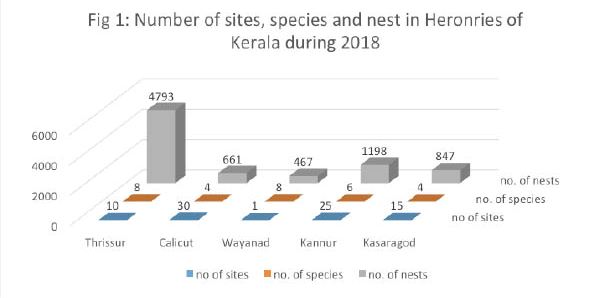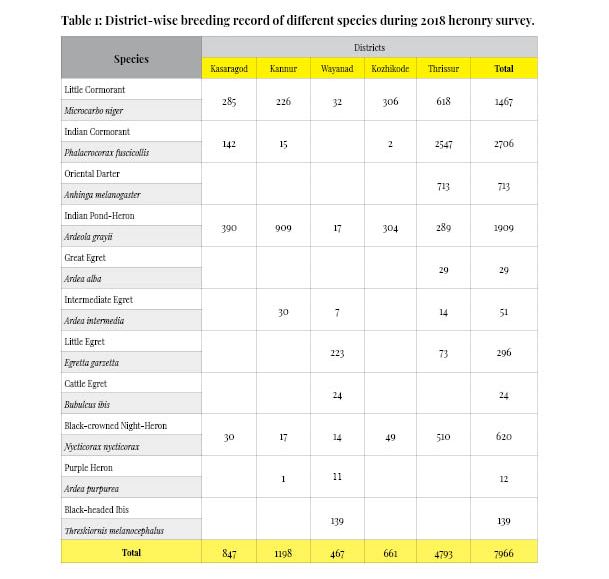Abstract
A total of 7966 nests of 11 species were recorded from Kasaragod, Kannur, Kozhikode, Wayanad and Thrissur districts of North Kerala during 2018 heronry survey. Highest number of sites was recorded in Kozhikode (30), while highest number of nests was recorded in Thrissur district (4793) and highest species count (8 species) from Wayanad District.
Introduction
Heronries are nesting colonies of waterbirds such as herons, egrets, cormorants, storks etc., which show temporal and spatial clumping of nest during breeding season. Counting of colonial nests is regarded as an effective and accurate way to determine the breeding population of water birds in an area. Being one of the top predators in the aquatic food chain, monitoring their population can indicate the health of the aquatic ecosystem, freshwater as well as brackish water. Organised heronry surveys have been carried out throughout the state of Kerala with the help of Kerala Forest Department, various NGOs and individuals.
Methodology
We followed the Heronry Census of Kerala Protocol (Sashikumar et al., 2015) for the survey. The count was carried during the peak of breeding season (July-August) in the region. Survey sites were selected from published data on nesting locations in the study area (Roshnath et al. 2018). In addition to the existing nesting sites, several other possible nesting sites were also surveyed so that data from the earlier surveys could be compared to assess the population trend. A press release was published in the local newspapers before the survey to get information on additional breeding sites. During the survey, the information such as the nesting species, number of nests of each species, number of nesting trees, species of nesting trees, tree height, predominant nesting stages, latitude and longitude of the location using Global Positioning System (GPS), etc., were recorded. Clusters of trees with nests within 300m were considered as one heronry.
Results and Discussion
During 2018 heronry survey, only five districts of Kerala (Fig 1) were covered. Highest number of heronry sites was recorded in Kozhikode (30 sites) followed by Kannur (25) and Kasaragod (15), while highest number of nests was recorded in Thrissur district (4793 nests). Highest species count (8 species) was recorded in Wayanad district.

A total of 7966 nests of 11 species were recorded during 2018 survey (Table 1). An increase in the nest abundance of Indian Cormorant Phalacrocorax fuscicollis (33.9%) was observed during the present survey. Followed by the Indian Pond-Heron Ardeola grayii (23.9%) and Little Cormorant Microcarbo niger (18.4%) which were the major nesting species found in most of the heronries. The trend of increase in the number of nests of Indian Cormorants was observed since 2016 survey especially in Thrissur district (Roshnath et al. 2018). A good number (N=510) of nests of Black-crowned Night-Heron Nycticorax nycticorax was also found in Thrissur.

As in 2017 and 2018 the same districts were covered, the data is good for comparison. Flood in Wayanad seemed to have drastically affected the nesting of Black-headed Ibis Threskiornis melanocephalus: from 424 nests in 2016, it has reduced to 139 nests. Comparative decline in nest abundance was also found for species such as Intermediate Egret Ardea intermedia and Great Egret Ardea alba for the current year. The major remark for the current year was a high dominance of Indian Cormorant over Little Cormorant.
References
Sashikumar C., Bimalnath KG, Hari Mavelikara, Harikumar Mannar, ES Praveen, Raju S, Roshnath R, Sathyan Meppayur, B Sreekumar, A K Sivakumar, CK Vishnudas, Praveen J and Nameer P O. (2015). Heronries of Kerala – 2014. Malabar Trogon 13(2&3):2-11.
Roshnath R., Sashikumar, C., Greeshma, P., Palot J. and Vishnudas C.K. (2018). Heronry Survey in Kerala, 2017– A Summary. Malabar Trogon 13(3): 67-70.
